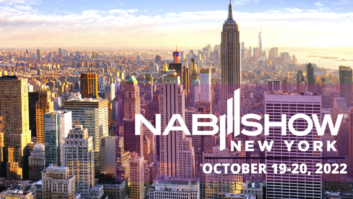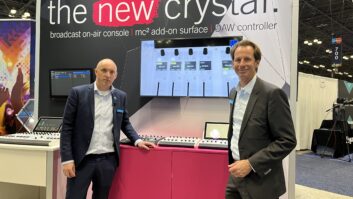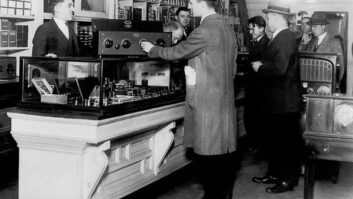(Editor’s note: This column contains postscripted material)
In recent months, a mixed bag of both promising and disturbing news has flowed fast and furious out of Ibiquity.
In May, the entire HD-R standards setting process officially was put on hold until the codec problems were resolved. Then Glynn Walden, the “godfather of IBOC,” suddenly was terminated, effective at the end of July.
As one of the founders of the technology and Ibiquity’s VP of engineering, Walden was by far the most reliable and respected interface between the company and broadcasters. Also falling under the ax were Rick Martinson, vice president of program management, and Gerald Marcovsky, senior legal advisor.
Further layoffs included the key players of the Warren, N.J., PAC development team. Deepen Sinha, the “godfather of PAC” and director of audio development, plus Ben Benjamin, senior VP and co-COO along with Thom Linden, VP of data development, are all gone.
Officially, Ibiquity said these employees “left the company.” That’s of course corporate code for being laid off or just flat fired. Ibiquity has been burning through cash rapidly as the sales rollout of HD-R has fallen behind its projected schedule. A total of roughly 32 employees left the company in recent months, cutting the payroll to about 80. Some observers say these cuts will shore up its ability to conserve cash and achieve its revised business plan expectations.
The in-house, Lucent-developed PAC algorithm also succumbed to CEO Bob Struble’s firing squad.
And the winner is …
On Aug. 12, Ibiquity unveiled its anxiously awaited codec fix. For the most part, MPEG won the closely watched round of dueling codecs. Ibiquity teamed up with Coding Technologies, the developer of AAC+, to come up with HDC for HD-R. The new name apparently was chosen to connote High Definition Coding to match the HD branding. As a close relative of AAC+, the new algorithm uses Spectral Band Replication, also part of the MPEG-4 technology.
Ibiquity finally realized that it is critically important to include key industry engineers as well as NRSC members in the evaluation process of its new codec before it is shown to the public or submitted for formal acceptance. Too much of its previous work on system development was done behind the curtain of secrecy.
In July, members of the NRSC along with various corporate engineering heads were invited to listen to HDC, in some cases without knowing what it was. They were impressed. Most of the previous grit and smear in the PAC codec used for AM at 36 kbps apparently is gone. Even 64 and 96 kbps versions for FM HD-R sounded better than previous codec demos. More engineers have since heard it at special demos at NPR.
There are still minor artifacts at low bit rates for AM, but not as obnoxious as with PAC.
“They got rid of virtually all of the objectionable artifacts,” one source said. “Only some codec coloration was noticed, but all the previous swirly stuff is gone.”
Several sources cited the use of Elton John’s “Goodbye Yellow Brick Road” as the “standard codec killer” cut to confirm that HDC performed well.
NRSC DAB Steering Committee chairman Milford Smith raved about the results, saying “the improvement in audio quality on AM is spectacular with the HDC codec and there is improvement in FM quality as well.” The demonstration included cascaded examples of audio compressed by other codecs, including ISDN and satellite material before being subjected to the final crunch for HD-R.
The NRSC is so confident the codec controversy is resolved that it has announced that the standards setting process has resumed. Let’s hope this is all bulletproof and the issue finally is laid to rest.
Cutting down to the bone
Sources have said that Ibiquity was top-heavy and that the roles played by Walden and Martinson to bring the technology from concept through development and now deployment essentially are completed. It is not unusual for technology companies to make such moves after the primary R&D phase is over and a product hits the market.
But others have suggested there may have been internal disagreement between various players in the company and those in Ibiquity management regarding the handling of the codec development and poor performance of PAC on AM HD-R. In this view, Walden primarily was interested in developing and delivering the IBOC product in a form that would best serve the broadcasting industry first, rather than the Ibiquity balance sheet.
Those who know Glynn Walden well felt he was never fully comfortable with the USADR and Lucent merger that formed Ibiquity, or the use of PAC as the codec of choice. Why President/CEO Bob Struble and others in the Ibiquity inner circle would choose to jettison Walden, perhaps their highest-profile spokesman and highly regarded proponent, just as the system was getting off the ground suggests a deep division existed within Ibiquity on how the company would proceed with development and marketing from here on. Glynn will be sorely missed and may be irreplaceable.
The departure of Sinha and Benjamin clearly signaled that the Ibiquity brass had finally lost confidence in the PAC codec. PAC did not keep up and stay in synch with the rest of HD-R’s development and deployment schedule. When important performance goals fall short in any big company, somebody’s gotta take the fall.
PAC is still used by Sirius satellite radio. Without leadership and management’s vote of confidence, you have to wonder how long PAC will survive as a viable product. Look for Sirius switching to AAC+ or HDC, or at a minimum adding the benefits of Spectral Band Replication.
Behind the scenes
Sources told Radio World that Rick Martinson had been working on integrating AAC+ for HD-R. With his departure, Ibiquity rejected that solution in favor of a new codec with its own name on it.
It’s now clear that Ibiquity teamed up with Coding Technologies to develop HDC many months before all the layoffs around the beginning of this year. “We’ve been working behind the scenes for quite some time on HDC and believe all of our commercialization partners will be thrilled with the audio quality of HD Radio,” Struble stated in his unveiling announcement.
Ibiquity is carefully calling HDC a new proprietary codec. That probably helped the company negotiate a better licensing deal and save face by not appearing to cave in to the MPEG AAC+ proponents.
By putting its own name on it, Ibiquity reassures the industry that it left no stone unturned to produce a codec most suited for HD-R. While it may contain elements from other algorithms, including PAC, it appears to be primarily a product of Coding Technologies and the MPEG-4 core technology.
Ibiquity’s budget most certainly did not contemplate having to license a different codec and dump its own product, already bought and paid for. The layoffs probably were needed to help pay for developing HDC and other costs.
Receiver manufacturers have been nervous about how this dueling codec complication would play out. Most are developing or using chips that can handle any codec for HD-R so that simple software changes will accommodate any codec of any flavor.
Philips is developing an AISC chip for this while TI uses DSP chips available to many receiver makers. Kenwood has long been working on this approach. Ultimately, this will serve the industry better over the long haul as further codec changes and refinements are invented and incorporated into the technology as software upgrades.
Still a noisy mess
Even if the codec is finally fixed, there are still troubling issues hounding AM as Ibiquity continues with the HD-R rollout.
The effects of adjacent-channel interference, especially from skywave, remain problematic and controversial. As stations come on the air with AM HD-R, the band will fill up with digital hash. Many stations are bound to be affected by this and will experience loss of both day and nighttime analog coverage to varying degrees.
If stations pay attention and choose to press the FCC for relief, the growth of AM HD-R could be seriously hampered. Implementing the hybrid phase of this technology will be messy and not without ongoing controversy and delay.
DRM to the rescue?
Even here in the heartland, some industry observers are touting DRM as a better alternative technology to AM HD-R here in the United States and are calling for face-off testing. Digital Radio Mondiale was invented as an all-digital replacement for international analog AM broadcasting below 30 MHz. With its official unveiling in June and impressive performance at various trade shows and demonstrations, DRM would seem to be a worthy candidate.
While it holds great promise for shortwave broadcasters where traditional analog listening is rapidly disappearing, dropping it in on the incredibly crowded U.S. AM broadcast band does not really solve the major problem faced by HD-R. Nor does it offer a hybrid digital/analog mode to allow analog to remain useable. While it could be done, DRM provides no information about that on its Web site or any other public communications. (Editor’s note: See postscript below..)
Even if DRM offers a hybrid mode with audio performance equal or better to HD-R, the digital modulation would have to be carried in the upper and lower sidebands as bookends to the existing analog carrier. They would spill into adjacent channels as interference just like HD-R.
Different but very similar
In the all-digital mode, AM HD-R undoubtedly will play very similar to DRM. Both use COFDM modulation schemes and codecs that are more similar than they are different. The major difference we see is that DRM is highly scalable and delivers a variable carrier capability to accommodate different channel bandwidths and frequency response needs, depending on the service.
DRM also offers selectable coding modes that are optimized to combat various propagation distortions inflicted by skywave for different frequency bands. And at least three different codec flavors can be selected by the user of DRM, depending on programming and channel bandwidth.
IBOC digital in the AM broadcast band will not need such a wide array of mode choices as those offered by DRM. Certainly we can see the benefit of some stations changing modes from day to night if their skywave audience is significant or they want to minimize the effects of skywave and groundwave mixing interference in fringe areas. Talk stations could choose a different codec and frequency response mode than music stations.
We see no reason Ibiquity would not seek to incorporate the best of the DRM offerings into the AM HD-R design as it evolves. They’ve already joined forces with an outside provider for a better codec. Even though Ibiquity claims all of the HD-R problems will be solved with their current design in the all-digital mode, DRM is an open-source standard, so borrowing features from it would be easy. By the time HD-R gets to the all-digital mode, it could well have morphed into a scaled down version of DRM.
Forging ahead
To launch HD-R effectively with a hybrid mode for both AM and FM that uses a common standard receiver chip, we are pretty much stuck with the Ibiquity model at this stage in the game. But with so many heads rolling off the table, it’s not clear who at Ibiquity will be watching out for broadcasters’ best interests as the HD-R saga plays out. Glynn Walden was the key player who could do that.
Can we now trust Bob Struble and the remaining technical staff to make the right decisions without a savvy broadcaster with technical expertise in his inner circle? As the rollout picks up steam, there will be many critical choices to be made that must safeguard the vitality and future growth of our enterprise and still allow Ibiquity to achieve success.
Don’t stop listening to us, Bob, and don’t let us down. Ibiquity can never succeed unless U.S. broadcasting continues to do so.
Guy Wire is the pseudonym for a veteran broadcast engineer with major-market radio credentials. His opinions are his own and do not necessarily reflect those of Radio World. RW welcomes other points of view.
Postscript:
Dear Guy,
The article “Ibiquity Charts a New Course” contains the following statements about DRM:
“Digital Radio Mondiale was invented as an all-digital replacement for international analog AM broadcasting below 30 MHz.” … “Nor does it offer a hybrid digital/analog mode to allow analog to remain useable.”
This statement is factually incorrect, since DRM does indeed have a “simulcast” mode which has both analogue and digital components.
The article also contains the following statement:
“While it could be done, DRM provides no information about that on its Web site or any other public communications.”
As the following sample links from the DRM website show, this statement is also factually incorrect:-
http://www.drm.org/newsevents/faqs/faq-053.htmhttp://www.drm.org/newsevents/faqs/faq-054.htmhttp://www.drm.org/newsevents/faqs/faq-055.htm
The RW Online website will be widely read within the US radio industry and a statement such as this is likely adversely to affect the perception of DRM as well as misinform your readership. I’m sure you’ll wish to publish a correction, particularly as you surely pride yourselves on the accuracy of your reporting.
Best wishes
Carey http://www.wohnort.demon.co.uk/DAB/
Guy responds:
Carey,
It’s always good to hear from merry old England, especially on matters of DAB.
Your cited claims of incorrect information regarding my review of the DRM hybrid or “simulcast” mode are technically accurate. I thought I had researched this issue carefully. The DRM simulcast mode does exist and apparently is still being tested, but it’s hardly a significant part of the system specification. The DRM website (www.drm.org) makes no mention of it whatsoever in system specifications, preferring instead to make only passing mention of it in 3 brief answers buried among 60 FAQ’s in the News & Events section…..which you cited and which I unfortunately missed. But I have to ask, if this were truly an important mode for DRM, why would it be almost invisible on the website and elsewhere throughout the trade press?
Clearly the reason is that DRM was conceived as a complete digital replacement technology for analog AM below 30 MHz, primarily in WARC regions 1 and 3. The inventors chose to focus on that instead of a fully developed hybrid compatible mode as Ibiquity has proposed to allow the preservation of existing analog transmission and reception. The 3 FAQ’s you cite indicate that the DRM simulcast mode was being tested and that further information would be forthcoming. Curiously these were last updated in June, 2002, almost 16 months ago.
FAQ 54 suggests that the DRM simulcast mode contemplates SSB or asymmetric/vestigial SB operation to reduce interference but at the expense of increased distortion. Further research seems to indicate that the 10 kHz DSB simulcast mode of DRM would not fit in the NRSC bandwidth mask limitation for our AM band. If this mode is to be useful in the US as an alternative to Ibiquity’s AM HD-R, a lot more tweaking, testing and revelation is needed.
The context of my remarks on DRM come out of the reality that Ibiquity has rigorously tested, demonstrated, and proposed as a standard their hybrid model which does fit in the NRSC mask and as such is a real and valid product. Yes there are some interference issues that will have to be dealt with, especially for nighttime operation. While DRM may have a hybrid mode that is being quietly evaluated behind the scenes, it still appears to me that it’s nowhere close to being a contender that could offer performance equal or better to Ibiquity’s HD-R for the US AM broadcast band.
— GW












